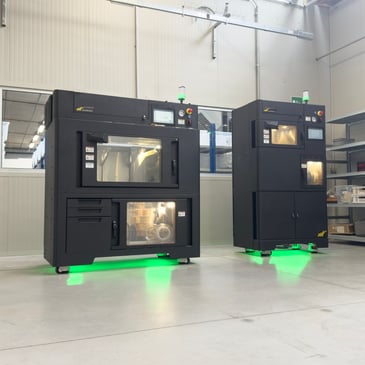3 min read
What Is FDM 3D Printing? How Fused Deposition Modelling Works
Fused Deposition Modeling (FDM) 3D printing is one of the best-known and most widely used additive manufacturing technologies in the world.Prized for...

Fused Deposition Modeling (FDM) 3D printing is one of the best-known and most widely used additive manufacturing technologies in the world.
Prized for its versatility, affordability, and reliability, FDM printing enables the creation of functional prototypes, mechanical parts, and custom components quickly and accurately.
FDM (Fused Deposition Modelling) 3D printing is one of the most well-known and widely used additive manufacturing technologies in the world.
Appreciated for its versatility, affordability and reliability, FDM printing makes it possible to create functional prototypes, mechanical parts and customised components quickly and accurately.
In this article you will find:
What FDM 3D printing is
How FDM technology works
Materials used in FDM 3D printing
Advantages of FDM 3D printing
Limitations and considerations
Applications of FDM 3D printing
FDM 3D Printing FAQ
Conclusion
FDM 3D printing, short for Fused Deposition Modelling, is a 3D printing technology that works through the extrusion of thermoplastic material.
A filament is heated until it melts and is deposited layer by layer to build the 3D model.
This additive manufacturing technology was developed in the late 1980s and is now widely used in both professional and hobbyist contexts.
GET A QUOTE FOR YOUR FDM-PRINTED PARTS
Model preparation
The 3D file is processed by slicing software, which divides it into layers and defines print paths and parameters (temperature, layer thickness, infill, speed).
Heating and extrusion
The thermoplastic filament is heated inside a nozzle until it reaches its melting temperature (between 180°C and 280°C).
Material deposition
The nozzle deposits the molten material onto the build platform, layer by layer, following the path defined by the software.
Solidification and layering
Each layer cools and solidifies immediately, adhering to the one below until the entire part is built.
Removal and post-processing
Once the print is complete, the part is removed, cleaned of any support structures, and, if necessary, finished with surface or mechanical treatments.
 Diagram showing how an FDM 3D printer works
Diagram showing how an FDM 3D printer works
FDM 3D printing offers a wide selection of thermoplastic materials, from common to high-performance ones.
Among the main options:
PLA – easy to print and ideal for aesthetic prototypes.
ABS – strong and durable, suitable for functional components.
Nylon (PA) – high mechanical resistance, also available reinforced with carbon fibre.
PEEK and Ultem (PEI) – high-performance materials, resistant to elevated temperatures and chemically aggressive environments; ideal for industrial and aerospace applications.
At Weerg, we offer a complete selection of technical materials for FDM 3D printing designed to meet any design requirement.
wide choice of materials
easy management and maintenance
ability to produce medium-sized parts
Need for support structures
Visible layer lines
Slightly lower mechanical properties along the vertical (Z) axis
FDM printing is used in numerous sectors:
Rapid prototyping → development and testing of functional models
Manufacturing industry → production of tooling, jigs, fixtures and technical components
Design and architecture → aesthetic and structural models
Automotive and aerospace → lightweight parts, supports and non-structural components
Education and research → teaching tool for engineers, designers and technical schools


FDM 3D printers available at Weerg: on the left the new Bambu Lab units, on the right the high-temperature printers for PEEK and Ultem.
The cost of FDM printing depends on several factors: material, volume, infill density and model complexity.
In general, it is one of the most affordable technologies, ideal for prototypes or small-series production.
At Weerg, FDM printing is available with maximum dimensions of 300 × 300 × 300 mm (11.8 × 11.8 × 11.8 in).
For high-performance materials such as PEEK and Ultem (PEI), print capacity extends up to 300 × 300 × 400 mm (11.8 × 11.8 × 15.8 in).
These dimensions allow the creation of large or assembled parts while maintaining consistent accuracy and quality even on large volumes.
FDM (filament): the most economical and versatile option; ideal for functional prototypes.
Limitations: rougher finish, lower detail and less uniform properties along the Z-axis.
MJF (HP Multi Jet Fusion): faster (batch printing by layers), isotropic properties and higher detail (~0.5 mm). Powder reusable up to 80%; also suitable for large production batches compared to FDM.
Resin (SLA/DLP): highest resolution and smooth surfaces; excellent for small and detailed parts. Requires handling of resins/UV and post-processing.
Recommended Insights:
Comparing FDM and MJF 3D Printing: Advantages and Differences
How to Choose Between Filament and Resin 3D Printing
FDM 3D printing represents a balance between accessibility, robustness and production flexibility.
Thanks to the wide range of available materials, it is a perfect technology for prototypes, industrial components and customised parts.
At Weerg, FDM is used for rapid prototyping and the production of functional parts, ensuring precision, reliability and fast delivery times.
At Weerg, FDM is used for rapid prototyping and production of functional parts, ensuring accuracy, reliability and fast lead times.
Start producing your FDM parts now with advanced technical materials

3 min read
Fused Deposition Modeling (FDM) 3D printing is one of the best-known and most widely used additive manufacturing technologies in the world.Prized for...

2 min read
HP Multi Jet Fusion (MJF) 3D printing technology continues to evolve through the introduction of new high-performance materials — and leading the way...

3 min read
The term annealing refers to a heat treatment used to modify the physical and mechanical properties of a material.From metals to polymers—and even ...